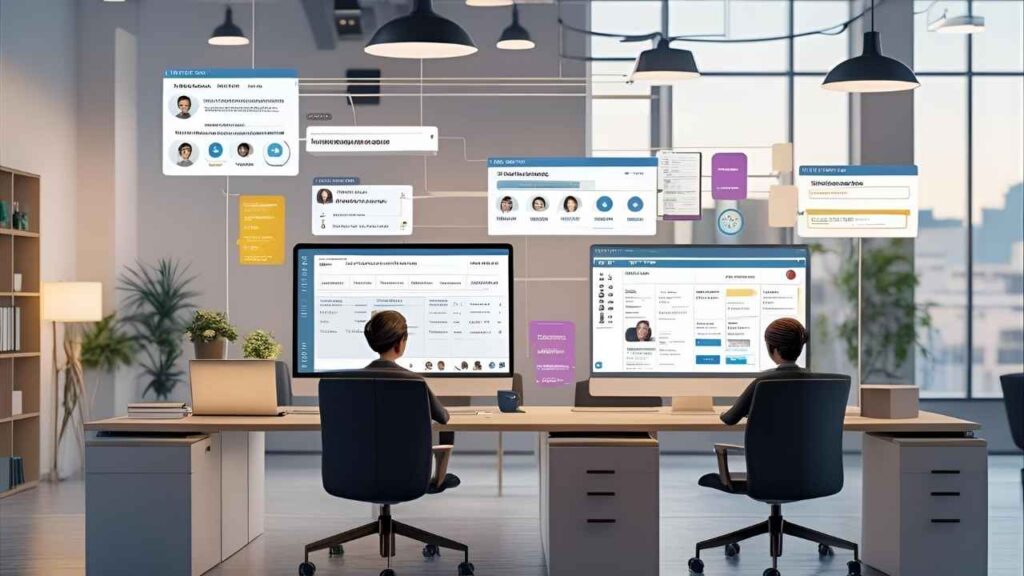IT ticketing systems are the central solution to the organization, which track, monitor, and resolve issues related to the organizational computer/IT-related problems and service requests. These tools can be the foundation of a new IT Service Management (ITSM) for more organized and logged phone calls and email chains, instead of a headache.
In this era of a digital-first approach to business, ITSM has gained importance as a means of keeping work efficient. The use of technology infrastructure in organizations necessitates the need to ensure a quick resolution of IT problems so as to avoid productivity losses and business continuity. When it is properly done, the ticketing system makes sure that no request drops through the cracks and also offers useful information on IT performance and user satisfaction.
Professional ticketing can offer a lot more than just plain issue tracking. Speed of resolving issues can be achieved using automations and smart routing, assigning attributes of clear accountability, and building smooth workflows that do not have any bottlenecks in these platforms. Also, they give detailed audit-trail data on compliance and elicit actionable analytics to deliver services better in a progressive way.
As a whole guide, this article assesses 10 of the best IT ticketing systems available in 2025, to enable businesses to make informed decisions on the basis of their factor requirements, budget, and company dynamics in a well-informed decision.
Key Features to Look for in IT Ticketing Systems
There are some key functions that should be considered when using IT ticketing systems, since they can become the basis of success or the cause of frustrations.
- Automation and workflow management capabilities help to minimize manual ticket routing through automatic routing and escalation of long overdue tickets and send notifications through it. Further solutions go as far as auto-resolving known problems based on knowledge base articles or predefined scripts.
- SLA management and escalation rules promote service delivery through checking on the response time and resolution time and automatically escalating tickets on the verge of breaching SLAs, in addition to having a real-time view of service levels of the performance indicators.
- Omnichannel ticket intake allows users with varying preferences by supporting an email request and using a web portal, chat option, phone integration, or even a mobile application. This adaptability enhances user uptake and complete capture of the request.
- Knowledge base integration enables end-users and agents to provide self-service, lowering the volume of tickets used and increasing the rate of first-call resolution. The problem can be solved with dynamic knowledge suggestions when creating the ticket and eliminating unsolvable problems before they turn into formal requests.
- Reporting and analytics deliver actionable measures through dashboards with custom data views, trend analysis, performance measurement, and satisfaction surveys. The features make it possible to conduct data-driven decision-making and constant improvement of the services.
- Integration with other IT tools can leverage the available infrastructure, such as Configuration Management Database (CMDB), monitoring systems, asset management solutions, and business applications to form a unified IT environment.
- User-friendly interface design has the advantage of benefiting agents in the IT sector, as well as the end-users, by being mobile responsive, with intuitive navigation and a customizable layout that lowers the training needs and enhances adoption levels.
- Scalability and customization options enable the system to expand as organizational requirements increase, and, as a result, it suits specialized business processes due to the use of custom fields, workflows, and chains of approval.
Comparison Table Between IT Ticketing Systems
| System | Starting Price | Deployment | Best For | Key Strength |
| Freshservice | $19/agent/month | Cloud | Mid-large enterprises | User experience & automation |
| Jira Service Management | $7.53/agent/month | Cloud/Server | Development-focused teams | Atlassian integration |
| Zendesk | $55/agent/month | Cloud | Customer experience focus | Omnichannel capabilities |
| ManageEngine ServiceDesk Plus | Get a quote | Cloud/On-premise | Budget-conscious organizations | Comprehensive features |
| ServiceNow | Custom pricing | Cloud/On-premise | Large enterprises | Platform scalability |
| SysAid | Get a quote | Cloud/On-premise | Automation-focused teams | AI-driven support |
| Spiceworks | Free/Cloud Premium $6/seat/month | Cloud | Small-medium businesses | Community & cost |
| SolarWinds Service Desk | Quote-based | Cloud/On-premise | Infrastructure-integrated | Monitoring integration |
| HappyFox | $21/agent/month | Cloud | UX-focused organizations | User experience |
| Zoho Desk | ₹540/user/month billed month | Cloud | Zoho ecosystem users | Business suite integration |
Top 10 Best IT Ticketing Systems
1. Freshservice
Website: https://www.freshworks.com/freshservice/
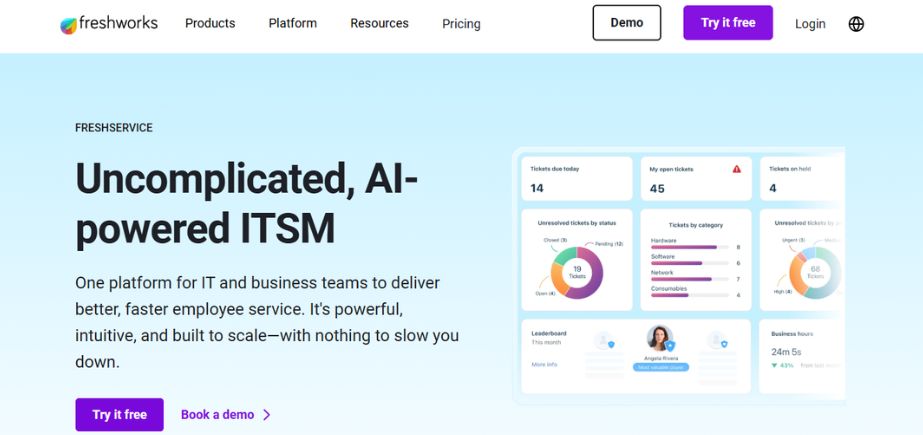
Freshworks Freshservice is one of the IT ticketing systems that best fits modern IT teams. It provides AI-driven automation, user-friendly ticketing, and strong asset and change management. Freshservice simplifies IT operations with its features such as SLA management, workflow automation, and a self-service portal. It easily interacts with other products of Freshworks and other tools. FreshService is ideal for businesses that want to grow a simple-to-configure, scalable solution that can be installed quickly and those wanting to expand their IT teams easily. Freshservice most suitably fits in the mid-sized enterprise and a fast-growing IT team.
Key Features:
- AI-powered automation with Freddy AI for intelligent ticket routing and resolution suggestions
- Comprehensive asset management with automated discovery and lifecycle tracking
- Built-in change management with approval workflows and risk assessment
- Advanced reporting with customizable dashboards and real-time analytics
- Omnichannel support including email, portal, chat, phone, and social media integration
Best For:
Mid-sized to large enterprises seeking comprehensive ITSM functionality with minimal complexity, organizations prioritizing user experience, and teams requiring robust automation capabilities.
Pros:
- Exceptional user interface design that reduces training requirements
- Comprehensive feature set covering all ITSM processes in a single platform
Cons:
- Higher pricing compared to basic ticketing solutions
- Advanced customization options may require technical expertise
Pricing:
Plans start at $19 per agent per month, with enterprise features available in higher tiers ranging up to $109 per agent per month.
2. Jira Service Management
Website: https://www.atlassian.com/software/jira/service-management
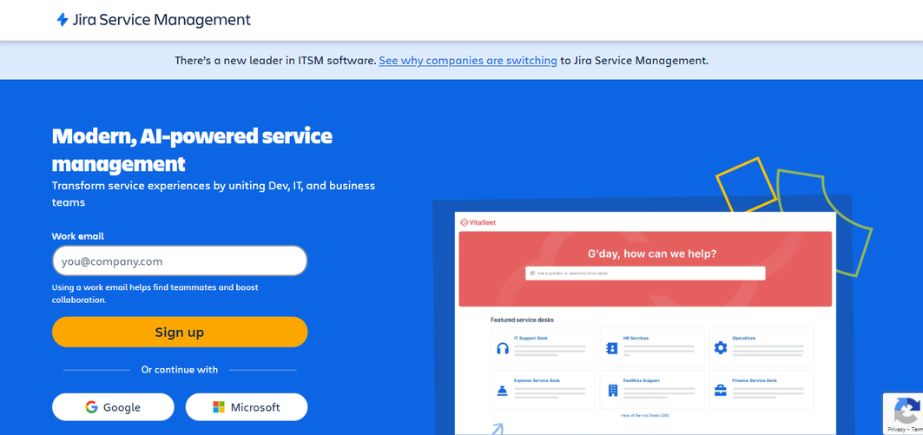
Jira Service Management is a robust ITSM solution and a powerful development by Atlassian that is particularly efficient in issue tracking, incident management, and DevOps integration. It sustains knowledge base integration, automation, and agile workflow through Confluence. It also enables teams to effectively handle requests by allowing customization of queues, SLAs, and strong reporting. It is common with the teams on development-intensive projects, and its effective use is together with organizations where Jira has already been established as a project tracking tool, which creates an easy unionization of the IT support and software development teams.
Key Features:
- Deep integration with Atlassian ecosystem including Jira Software and Confluence
- Advanced automation engine with no-code rule builder
- Powerful SLA management with flexible escalation policies
- Comprehensive asset and configuration management
- Developer-focused incident management with code deployment tracking
Best For:
Organizations already using Atlassian products, IT teams supporting software development, and companies requiring extensive customization and workflow flexibility.
Pros:
- Seamless integration with development tools and processes
- Highly customizable with extensive third-party app marketplace
Cons:
- Steeper learning curve for non-technical users
- Can become complex with aextensive customization
Pricing:
Standard plan starts at $7.53 per agent per month, with premium features available up to $13.53 per agent per month.
3. Zendesk
Website: https://www.zendesk.com/in/
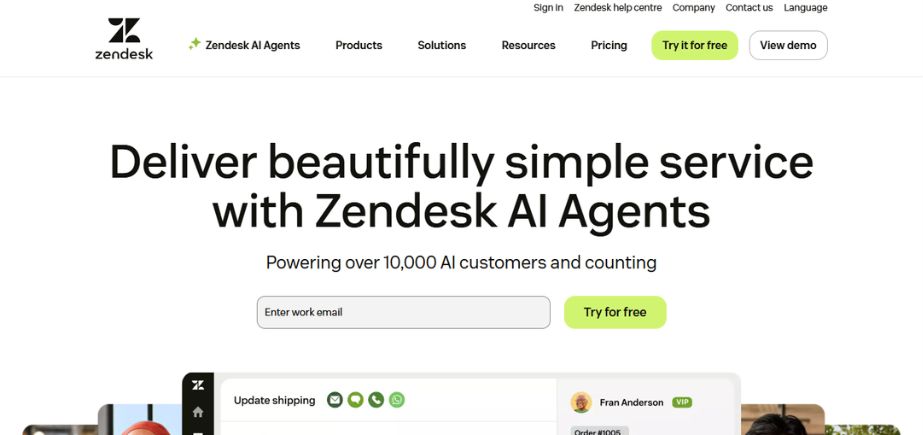
As a customer support and IT helpdesk tool, Zendesk is highly flexible and can support IT and tight-knit customer support teams with powerful ticketing, automation, and omnichannel behavior. It enables the user to handle the IT ticket by email, chat, on social media, and on the phone, all on a single dashboard. Zendesk allows using customizable workflows and AI-based bots, as well as supports internal IT issues and customers in receiving and providing support. It is most appropriate in businesses looking forward to an easy, scaled-down helpdesk with good customer experience features.
Key Features:
- Unified omnichannel experience across email, chat, phone, and social media
- Advanced AI and machine learning for automated responses and routing
- Comprehensive knowledge base with community forums
- Robust reporting suite with custom dashboards and business intelligence
- Extensive marketplace with over 1,000 apps and integrations
Best For:
Organizations prioritizing customer experience, companies with diverse communication channel requirements, and businesses seeking extensive third-party integrations.
Pros:
- Industry-leading omnichannel capabilities
- Extensive integration ecosystem and marketplace
Cons:
- ITSM-specific features may require additional configuration
- Pricing can escalate quickly with advanced features
Pricing:
Professional plan starts at $55 per agent per month, with enterprise features available in higher tiers.
4. ManageEngine ServiceDesk Plus
Website: https://www.manageengine.com/
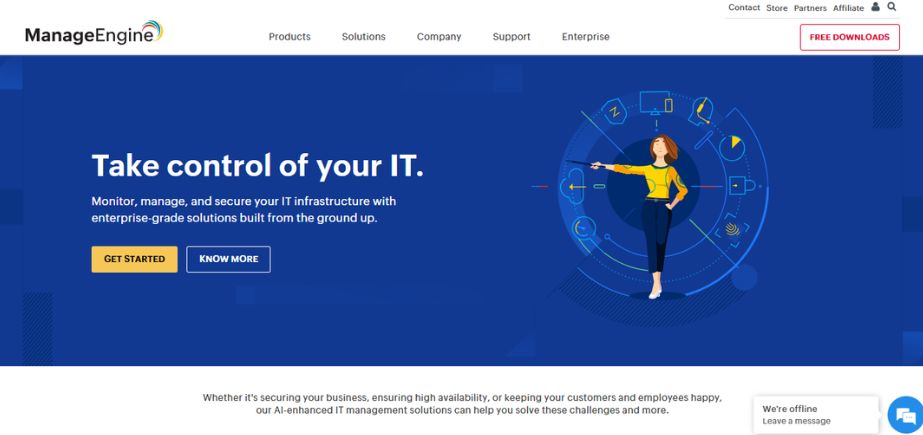
Being an ITIL-compatible ticketing solution, ManageEngine ServiceDesk Plus is an end-to-end IT support tool that facilitates IT support teams. It accommodates incident, problem, and change as well as asset management, and this is why it fits well in organizations that have well-established ITSM practices. It has automation, a self-service portal, CMDB support, and is available on-premise or in the cloud. Full of customization and reporting options, it is viable in mid-to-large companies that require rich functionality, but do not want the complexity of enterprise-heavy tools such as ServiceNow.
Key Features:
- Integrated IT asset management with automated discovery
- Comprehensive project management with Gantt charts and resource allocation
- Advanced workflow automation with visual workflow designer
- Built-in remote desktop support for faster issue resolution
- Extensive customization options with custom fields and modules
Best For:
Budget-conscious organizations requiring comprehensive ITSM features, companies needing integrated asset management, and IT teams seeking value-for-money solutions.
Pros:
- Comprehensive feature set at competitive pricing
- Strong asset management capabilities integrated within the platform
Cons:
- User interface may feel dated compared to modern alternatives
- Advanced features may require technical expertise to configure
Pricing:
Get a quote
5. ServiceNow
Website: https://www.servicenow.com/
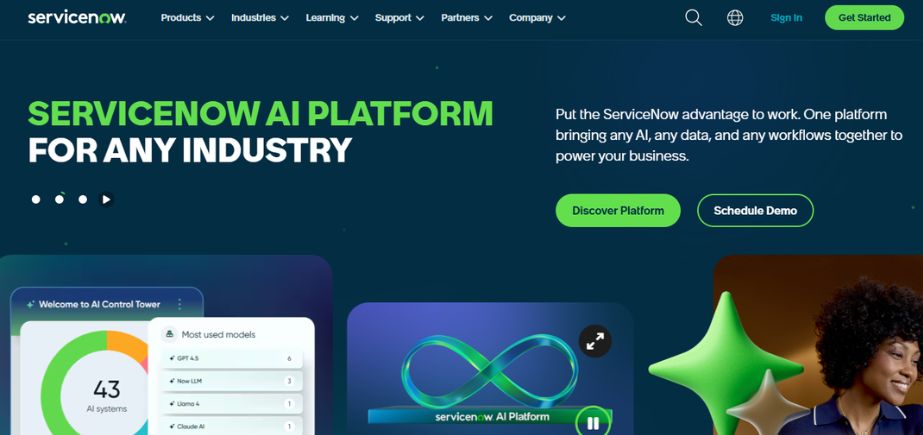
ServiceNow is one of the ITSM-focused platforms in the market, and the features available out of the box provide enterprise-level functionalities in the front of IT operations and asset management, incident response, and workflow automation. Industrious AI and analytics, deep integrations, and a low-code development environment provide it with the capabilities to tackle life in complex, large-scale environments. ServiceNow accommodates basic ticketing all the way up to total workflow digitalization. It is suitable in large enterprises that require a modular system that is highly scalable and one that can be moulded to fit in IT service streamlining to align IT operations to business objectives.
Key Features:
- Enterprise-scale platform with unlimited customization possibilities
- Advanced AI and machine learning capabilities through Now Intelligence
- Comprehensive CMDB with automated discovery and dependency mapping
- Integrated IT operations management with event correlation
- Platform-as-a-Service capabilities for custom application development
Best For:
Large enterprises with complex IT environments, organizations requiring extensive customization, and companies seeking to unify service management across multiple departments.
Pros:
- Unmatched scalability and enterprise-grade capabilities
- Comprehensive platform approach enabling cross-departmental service management
Cons:
- Significant implementation complexity and cost
- Requires dedicated resources for administration and customization
Pricing:
Custom pricing
6. SysAid
Website: https://www.sysaid.com/
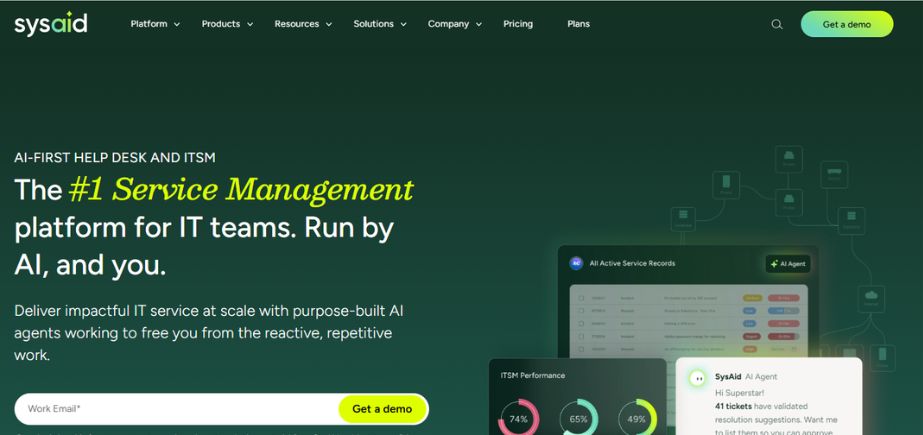
SysAid is a asset management, automation, and amongst the IT ticketing systems. This is because SysAid, which is highly flexible and has its use simplified, aids ITIL-related IT practices such as incident, problem, and change management. It consists of self-service portals, remotely accessing desktops, and accompanying analytics. A powerful tool with a good level of customization, as well as cloud and on-premise deployment, SysAid is a suitable product to meet the needs of mid-sized companies and IT departments that want to have a feature-rich yet low-cost tool as an alternative to enterprise ITSM solutions.
Key Features:
- AI-powered chatbot for automated first-level support
- Integrated remote desktop support with session recording
- Comprehensive asset management with barcode scanning
- Advanced workflow automation with approval processes
- Mobile-first design with full-featured mobile applications
Best For:
Organizations seeking to reduce manual workload through automation, companies requiring strong mobile capabilities, and IT teams focused on improving first-call resolution rates.
Pros:
- Strong AI and automation capabilities that reduce manual work
- Comprehensive mobile applications for technicians and end-users
Cons:
- Some advanced features require higher-tier plans
- Customization options may be limited compared to enterprise platforms
Pricing:
Get a quote
7. Spiceworks
Website: https://www.spiceworks.com/
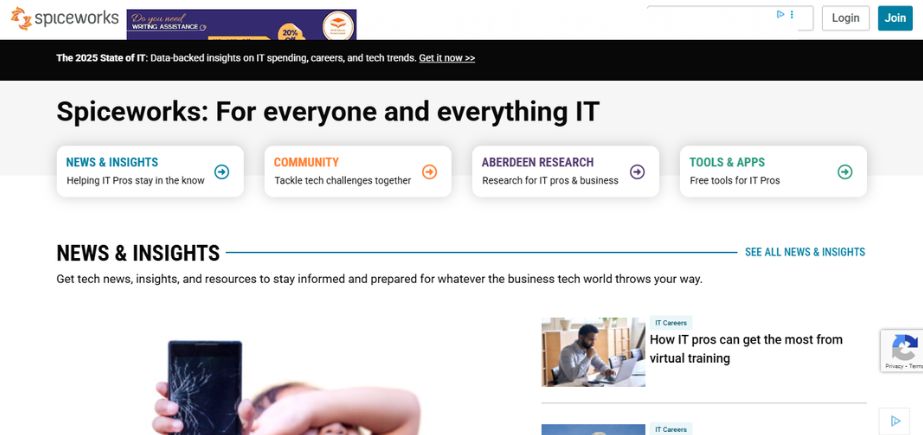
Spiceworks is a free, ad-supported IT helpdesk that is tailored to small and medium-sized IT departments. It comprises ticket tracking, user portals, management of a knowledge base, as well as mobile support applications. It has basic functionality, which is good, though lacking advanced options like enterprise tools; this makes it ideal when dealing with groups of individuals handling IT problems inside an organization. Spiceworks even has a community forum and inventory tracking systems. It is ideal when organizations have a simple need and modest budgets, and desire a no-cost single-component IT ticketing alternative.
Key Features:
- Free core ticketing functionality with optional paid enhancements
- Integrated network monitoring and inventory management
- Community-driven knowledge base with peer support
- Built-in help desk with email integration
- Mobile applications for ticket management on-the-go
Best For:
Small to medium businesses with limited budgets, IT teams seeking community support, and organizations requiring basic ticketing functionality without ongoing costs.
Pros:
- Free core functionality makes it accessible to any organization
- Strong community support and knowledge sharing
Cons:
- Limited advanced features compared to paid solutions
- Ad-supported model may not be suitable for all organizations
Pricing:
Core ticketing features are free, with Cloud Help Desk premium features starting at $6 per technician per month.
8. SolarWinds Service Desk
Website: https://www.solarwinds.com/
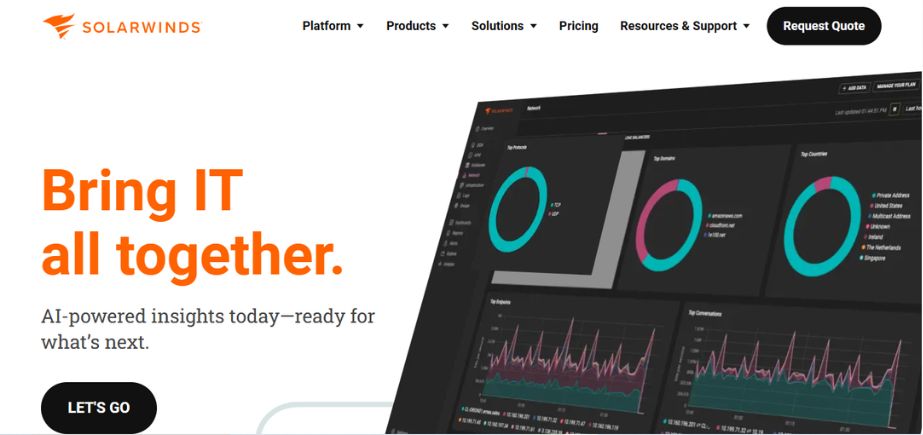
SolarWinds Service Desk is an ITSM software that runs on the cloud and ensures that service delivery is enhanced via automation, ticketing, and asset management. It helps in ITIL best practice, includes suggestions through AI, workflow automation, and rich reporting. It facilitates integrating IT processes with its integrations on different platforms. The product is simple to implement and easy to use, and is well-suited to the mid-sized organizations that are looking at the possibility of a scalable platform that has powerful change and incident management capabilities and that is strongly focused on user experience.
Key Features:
- Integration with SolarWinds monitoring tools for proactive issue detection
- Automated ticket creation from monitoring alerts
- Comprehensive knowledge management with approval workflows
- Advanced SLA management with flexible escalation rules
- Built-in customer satisfaction surveys and feedback collection
Best For:
Organizations already using SolarWinds monitoring tools, IT teams requiring integrated infrastructure monitoring, and companies seeking proactive incident prevention.
Pros:
- Seamless integration with SolarWinds monitoring ecosystem
- Proactive incident management through automated alert processing
Cons:
- Limited functionality when used standalone without other SolarWinds products
- May be overkill for organizations not requiring infrastructure integration
Pricing:
Quote-based
9. HappyFox
Website: https://www.happyfox.com/
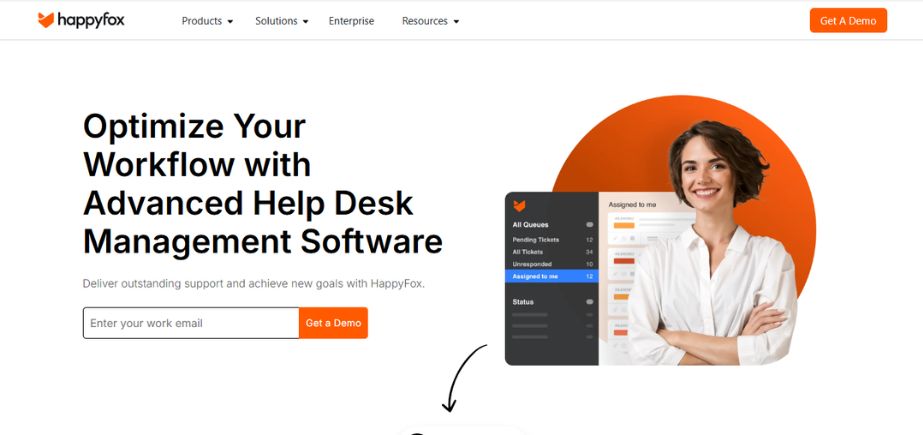
HappyFox is the latest help desk and ticketing software to be used in internal IT assistance and customer care. It has omnichannel ticketing management, automation, SLA monitoring, and self-service portals. HappyFox is clear in its interface and user-friendly setup. It can expand according to the increasing business requirements through add-ons to handle assets and live chat. It is appropriate for SMBs and mid-market companies that want a program that is inexpensive and can still be effective at a low level of training.
Key Features:
- Smart automation with intelligent ticket routing and prioritization
- Multichannel support including email, chat, phone, and social media
- Advanced reporting with customizable dashboards and analytics
- Built-in time tracking and billing capabilities
- Comprehensive mobile applications for agents and customers
Best For:
Organizations prioritizing user experience, companies requiring strong multichannel support, and businesses seeking automation-driven efficiency improvements.
Pros:
- Excellent user experience design for both agents and end-users
- Strong automation capabilities that improve efficiency
Cons:
- May lack some advanced ITSM features required by enterprise organizations
- Pricing can increase significantly with additional channels and features
Pricing:
Plans start at $21 per agent per month, with enterprise features available in higher tiers up to $89 per agent per month.
10. Zoho Desk
Website: https://www.zoho.com/en-in/desk/
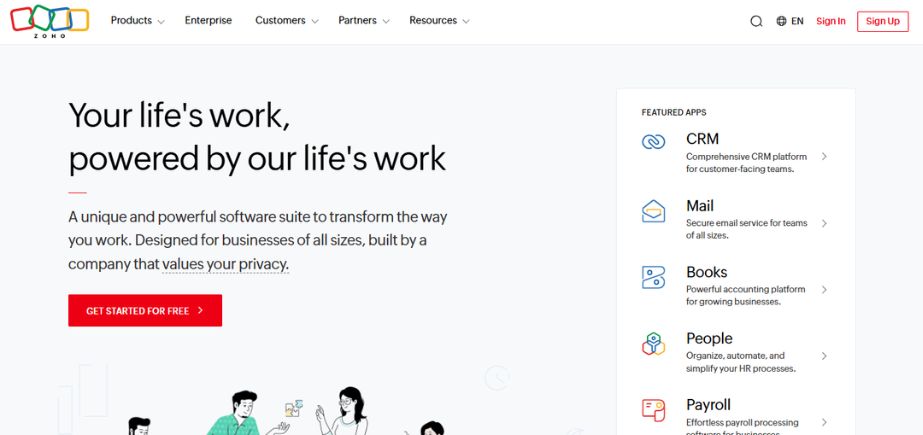
Zoho Desk is an AI-powered cloud-based ticketing/customer support application replete with robust automation, AI, and multichannel support. It is more commonly used in customer service, and it is more and more being considered on internal IT helpdesks. It has SLA management, ticket prioritization, a knowledge base, and integrations with the Zoho ecosystem. It has great customization and analytics that help IT teams achieve smooth processes. Zoho Desk will suit small to medium businesses that require an IT support solution on a budget.
Key Features:
- Integration with complete Zoho business suite
- AI-powered assistant (Zia) for intelligent automation and insights
- Multichannel ticket management with unified customer history
- Advanced analytics with custom reports and dashboards
- Comprehensive mobile applications with offline capabilities
Best For:
Organizations using other Zoho applications, small to medium businesses seeking integrated business solutions, and companies requiring strong mobile capabilities.
Pros:
- Excellent integration with Zoho business ecosystem
- Competitive pricing with comprehensive features
Cons:
- Best value realized when using multiple Zoho products
- Some advanced ITSM features may require customization
Pricing:
Starts at ₹540/user/month billed month
How to Choose the Right IT Ticketing Systems for Your Business
Choosing the best IT ticketing systems should be an exercise where organizational requirements, technological needs, and strategic development needs should be keenly considered.
- Assessing team size and support needs forms the foundation of system selection. Depending on the size of the team, it is possible to use simpler solutions with easy-to-use interface, or ones with workflow management, complex reporting, and expansion capability. When assessing capacity requirements, current volumes of tickets will need to be considered as well as high support activity, and future growth.
- Budget and licensing model considerations encompass not only extra expenses of subscription but also implementation cost, training cost, and maintenance costs after. Others have per-agent pricing which is linearly scaled, and others are volume-price discounted or otherwise price differently based on usage or features. Cost to cover other modules, integration, and professional services should be factored.
- Industry-specific compliance requirements can demand certain data security authorisation, auditability or data processing activities. Hospitals and medical organizations have to be HIPAA compliant, banks and financial institutions are going to need to be SOX compliant and even government agencies may need to be FedRAMP certified. Selected systems have to comply with regulatory requirements that are not cumbersome.
- Integration needs and tech stack compatibility ensure efficiency of the ticketing system with the already existing IT infrastructure. Assess the necessary links to monitoring tools, asset management system, Active Directory and business applications. Pre-built integrations reduce implementation complexity and ongoing maintenance requirements.
- Customization and reporting preferences should align with organizational workflows and decision-making processes. Other teams want out-of-the-box functions and minimal configuration ability and others want very robust configure functions. Think of such requirements as custom fields, approval processes, and custom reporting requirements.
Conclusion
Contemporary IT service management hinges on well-designed ticketing systems to convert the reactive support model to proactive service delivery. The platforms that are reviewed in this guide are market leaders at the moment and have different strengths that suit different organizational requirements and technological demands.
Strategy Business Objectives Implementation of good ITSM practices is not just a matter of addressing simple issues; it has to do with strategic business goals such as efficiency in operations, satisfaction of users, and compliance with regulations of operations. Companies that invest in the right ticketing systems will place themselves in a position to achieve better service delivery, a decrease in their operational cost, and business-enhanced agility.
Organizations must carry out an effective evaluation of shortlisted platforms, either by putting them through a test or a demonstration, before final decisions on selecting the platforms can be made. Such practical experience brings out issues of usability, integration issues, and term gaps that might not be evident by merely looking at a list of features.
The result of successful ticketing implementation is that success is determined by implementation, adoption by the users, and optimization. You might want to consider involving vendor professional services teams, designing and making elaborate training programs, and creating means of feedback to make the best use of the return on investment.
As an organization desiring to enhance its ITSM experience, some great assets it can use are the ITIL framework guidelines, guides on incident management-based best practices, and service request optimization plans to complement the powerful ticketing system integrations.
FAQs
What is the difference between helpdesk software and IT ticketing systems?
Although most of these terms are used interchangeably, IT ticketing systems tend to be more specific in addressing the IT-related problems or service requests with various features such as asset tracking, change request control, and infrastructure integration. Helpdesk software also tends to include more comprehensive customer service features that may cover multiple departments, such as HR, facilities, and customer service. Current ITSMs tend to include both categories as well.
Will small businesses have the advantage of using IT ticketing systems?
Absolutely. The ticketing systems usually have a more dramatic impact on small businesses due to the fact that they normally do not have a proper support process or IT personnel. Even simpler ticketing functionality gives accountability, avoids missing requests, and generates useful documentation. Lots of answers have low free plans specialized in smaller organizations.
Does IT ticketing have free or open-source tools?
There are a number of very good free and open-source software packages available, such as osTicket, OTRS, Request Tracker, and Zammad. Although they involve more technical know-how to implement and support, these solutions are much more comprehensive and do not involve any licensing expenses. There are also some commercial vendors that have their free version available as add-ons.
